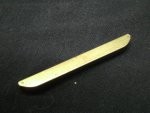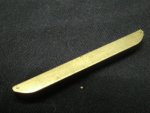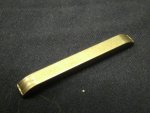Wow - thanks to all of you for the feedback and input. Learned A LOT during this repair.
Soon after my last post, I managed to find the TM (thanks to SS) and found the correct removal AND re-install procedure for the damper. Reading that along with seeing the condition of the key (and keyway), I came to pretty much the same conclusion. I had already ordered a new key and when it arrived, I checked the fit and it was very tight. The new damper would not go onto the crank more than about 1/8", so I felt that was a good sign. However, at the front of the keyway, you could still see a widening to the counterclockwise side (opposite rotation), I realized that the damper must have been moving when torqued and wearing both the key and keyway (as was mentioned by welldigger). I removed the timing cover, oil slinger and inspected the gear and keyway. To address the damage to the keyway (since removing the crank was not a current option), I set the new key in place using Belzona 1100, and filled the area where the crank was worn. I consulted Belzona about the intended use and they agreed that it would serve that purpose. Before the Belzona set, I removed excess to ensure that the damper would not be restricted when installed. This holds the key in place and eliminates the "void".
We polished the exposed portion of the crank, new slinger, replaced the timing cover and seal and then installed the damper strictly following the TM -
1) "HEAT THE DAMPER" and install using welding gloves" - we used an induction heater to get the damper up to about 250 degrees
2) "Lubricate the crankshaft and damper hub" - we used engine rebuilding lube.
3) "Install damper using installer" - while still hot, we used a rod, the retaining washer and nut to slowly draw the damper onto the crank. It was very tight, but went on VERY smoothly.
4) I made a 'key plug / seal' out of EDPM rubber and installed it in front of the key (saw that on the TM blow up, but no one sold it).
5) We removed the rod, installed the retaining washer and bolt and torqued it to the 250 ft lb spec.
In my opinion, the damper installed before the one we installed four years ago was likely not installed correctly, leading to all of the conditions mentioned. When the one was installed 4 years ago, the key was not replaced, the damper wasn't lubricated or HEATED when installed, therefore the problem never got solved. I certainly can't / don't fault the friends who installed it 4 years ago, because in all of my conversations, no one seemed to disagree with how it was installed - even some serious diesel mechanics. None had heard of the need to lubricate AND heat the damper. Had I not taken the time to research the TM for both removal AND install, this would not have come to light - and we would have installed it wrong AGAIN.
Anyway, all in all, I'm VERY confident that we've minimized the condition and I'm certain that this should hold up a long time (last one held up for 4 years). I now have a replacement engine LDS465 - which would minimize my down time. Then I can rebuild the LDT, repair (or replace) the crank at my leisure (what's that?)
I truly hope that this information helps someone sometime.
Once again - THANK YOU ALL for your thoughts, comments, recommendations. I take these VERY seriously. I truly enjoy the honor of working on these Veterans and proud to be a part of the MV world and appreciate that there's a group of people out there willing to help in any way.
Be well - be safe!!




